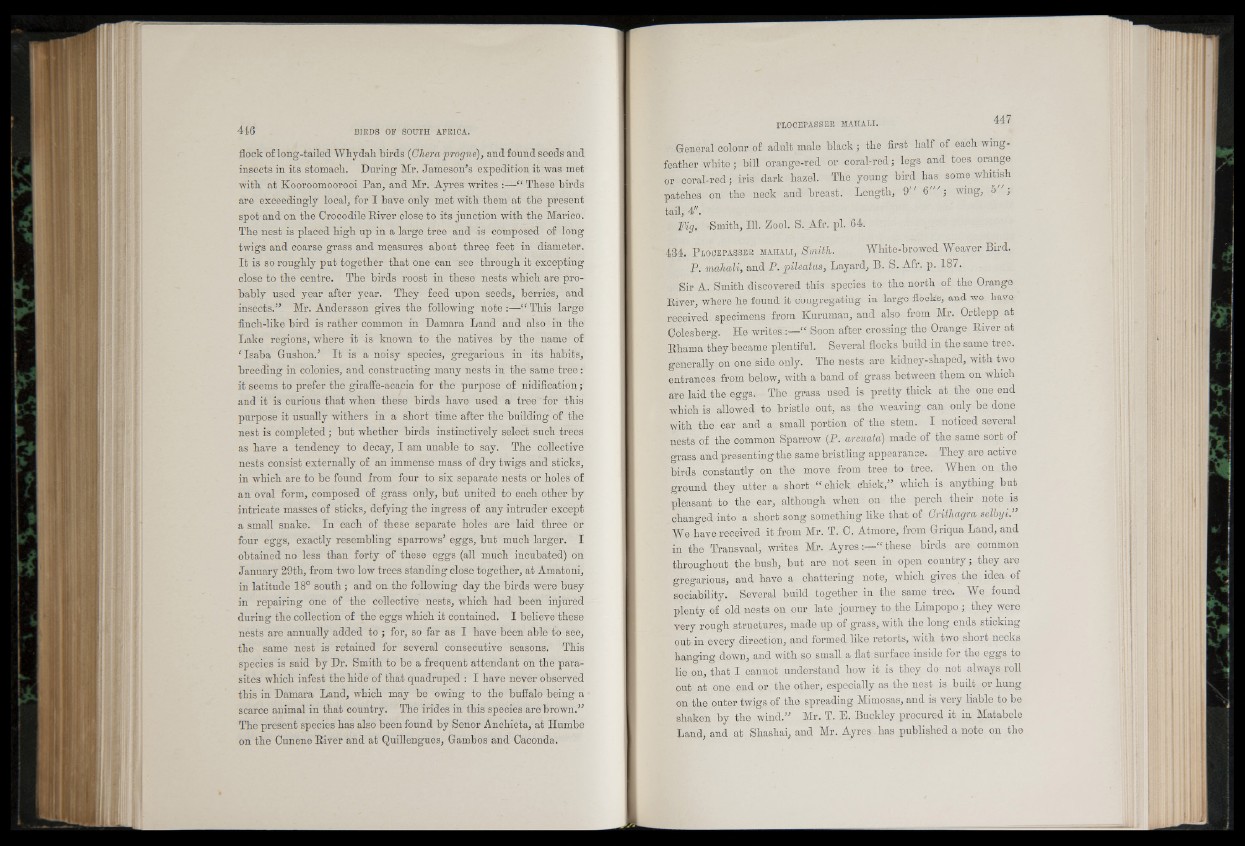
flock of long-tailed Wkydak. birds {Ohera progne), and found seeds and
insects in its stomach. During Mr. Jameson’s expedition it was met
with at Kooroomoorooi Pan, and Mr. Ayres writes :—“ These birds
are exceedingly local, for I have only met with them at the present
spot-and on the Crocodile River close to its junction with the Marico.
The nest is placed high up in a large tree and is composed of long
twigs and coarse grass and measures about three feet in diameter.
It is so roughly put together that one can see through it excepting
close to the centre. The birds roost in these nests which are probably
used year after year. They feed upon seeds, berries, and
insects.” Mr. Andersson gives the following note:—“ This large
finch-like bird is rather common in Damara Land and also in the
Lake regions, where it is known to the natives by the name of
f Isaba Gushoa.’ It is a noisy species, gregarious in its habits,
breeding in colonies, and constructing many nests in the same tree :
it seems to prefer the giraffe-acacia for the purpose of nidification;
and it is curious that when these birds have used a tree for this
purpose it usually withers in a short time after the building of the
nest is completed; but whether birds instinctively select such trees
as have a tendency to decay, I am unable to say. The collective
nests consist externally of an immense mass of dry twigs and sticks,
in which are to be found from four to six separate nests or holes of
an oval form, composed of grass only, but united to each other by
intricate masses of sticks, defying the ingress of any intruder except
a small snake. In each of these separate holes are laid three or
four eggs, exactly resembling sparrows’ eggs, but much larger. I
obtained no less than forty of these eggs (all much incubated) on
January 29th, from two low trees standing close together, at Amatoni,
in latitude 18° south; and on the following day the birds were busy
in repairing one of the collective nests, which had been injured
during the collection of the eggs which it contained. I believe these
nests are annually added to ; for, so far as I have been able to see,
the same nest is retained for several consecutive seasons. This
species is said by Dr. Smith to be a frequent attendant on the parasites
which infest the hide of that quadruped : I have never observed
this in Damara Land, which may be owing to the buffalo being a
scarce animal in that country. The irides in this species are brown.”
The present species has also been found by Senor Anchieta, at Humbe
on the Ounene River and at Quillengues, Garnbos and Caconda.
PLOCEPASSER MAH ALI.
General colour of adult male black; the first half of each wing-
feather white; bill orange-red or coral-red; legs and toes orange
or coral-red; iris' dark hazel. The young bird has some whitish
patches on the neck and breast. Length, 9 ' 6 '; wing, 5 ,
tail, 4".
Fig. -Smith, 111. Zool. S. Afr. pi. 64.
4 3 4 . P l o c e p a s s e r m a h a l i , Smith. White-browed Weaver Bird.
P. mahali, and P. pileatus, Layard, B. S. Afr. p. 187.
Sir A. Smith discovered this species to the north of the Orange
River, where he found it congregating in large flocks, and we have
received specimens from Kuruman, and also from Mr. Ortlepp at
Colesberg. He writes::—“ Soon after crossing the Orange River at
Rhama they became plentiful. Several flocks build in the same tree,
generally on one side only. The nests are kidney-shaped, with two
entrances from below, with a band of grass between them on which
are laid the eggs-.- The grass used is pretty thick at the one end
which is allowed to bristle out, as the weaving can only be done
with the ear and a small portion of the stem. I noticed several
nests of the common Sparrow (P. arcuata) made of the same sort of
grass and presenting the same bristling appearance. They are active
birds constantly on the move from tree to tree. When on the
ground they utter a short “ chick chick,” which is anything but
pleasant to the ear, although when on the perch their note is
changed into a short song something like that of Orithagra selhyi.”
We have received it from Mr. T. C. Atmore, from Griqua Land, and
in the Transvaal, writes Mr. Ay r e s t h e s e birds are common
throughout the bush, but are not seen in open country; they are
gregarious, and have a chattering note, which gives the idea of
sociability. Several build together in the same tree. We found
plenty of old nests on our late journey to the Limpopo; they were
very rough structures, made up of grass, with the long ends sticking
out in every direction, and formed like retorts, with two short necks
hanging down, and with so small a flat surface inside for the eggs to
lie on, that I cannot understand how it is they do not always roll
out at one end or the other, especially as the nest is built or hung
on the outer twigs of the spreading Mimosas, and is very liable to be
shaken by the wind.” Mr. T. E. Buckley procured it in Matabele
Land, and at Shashai, and Mr. Ayres has published a note on the